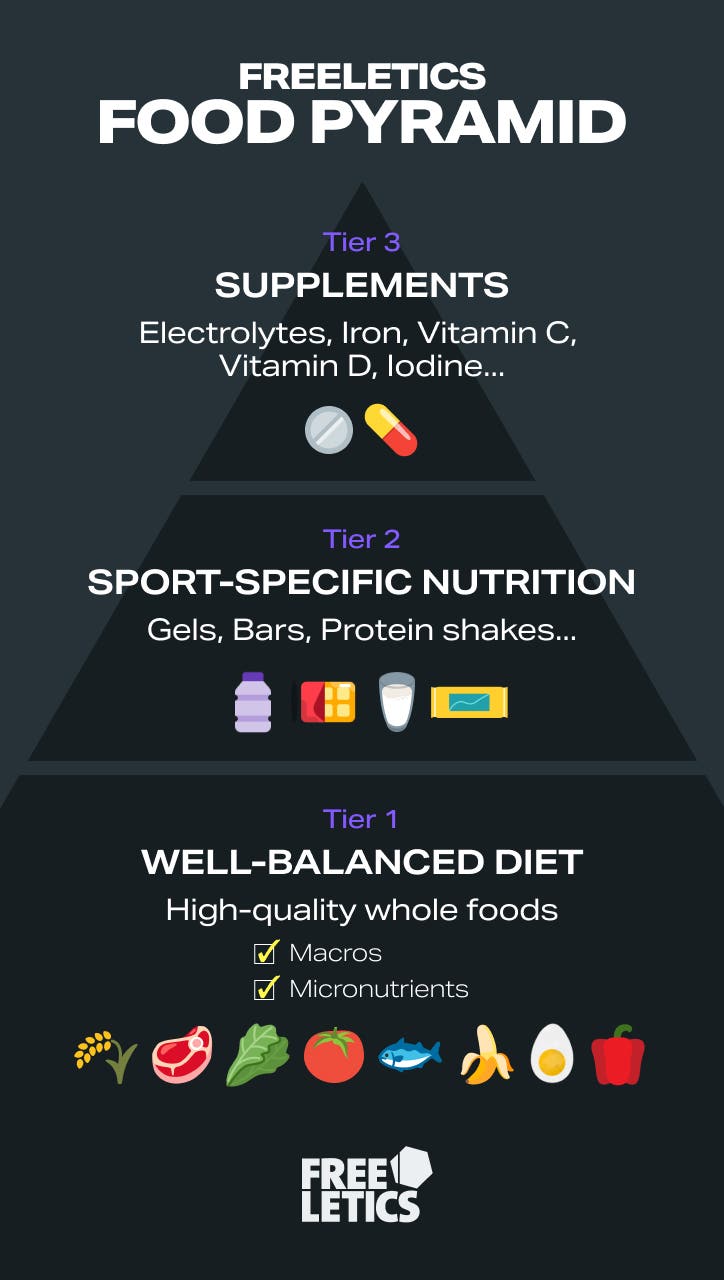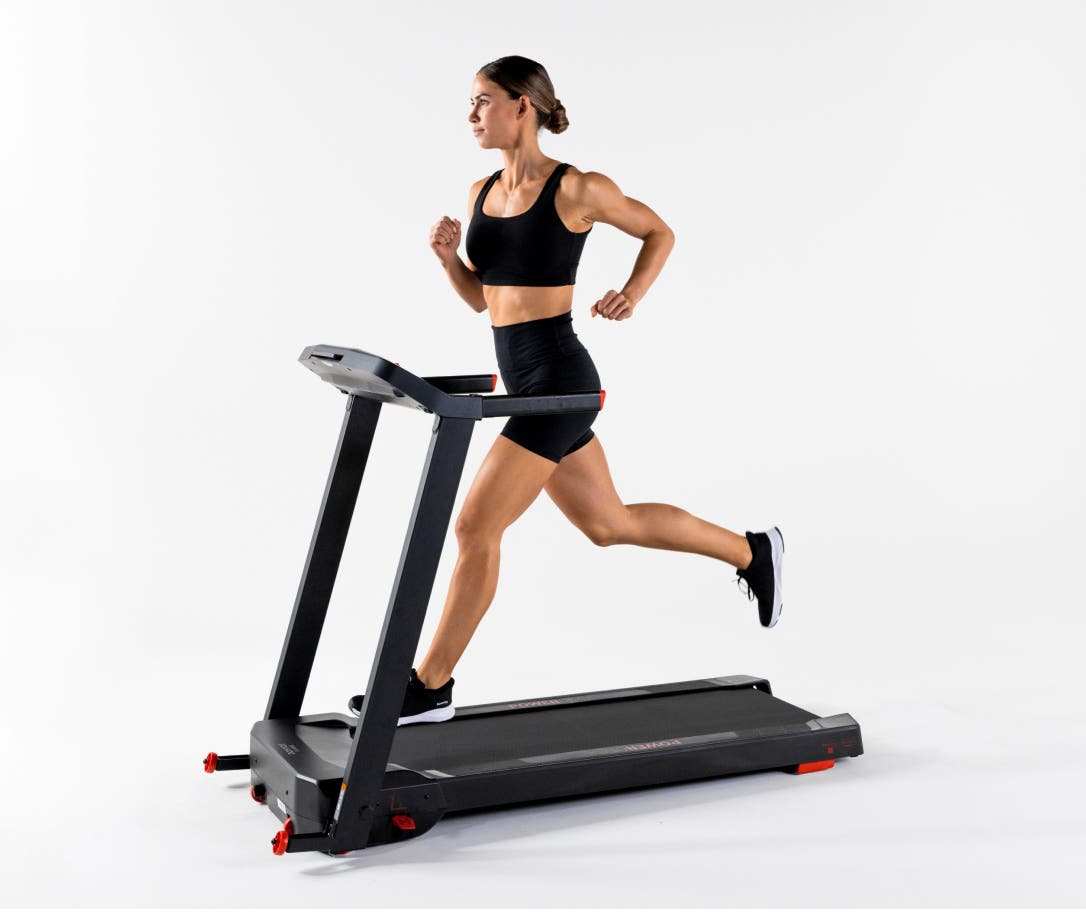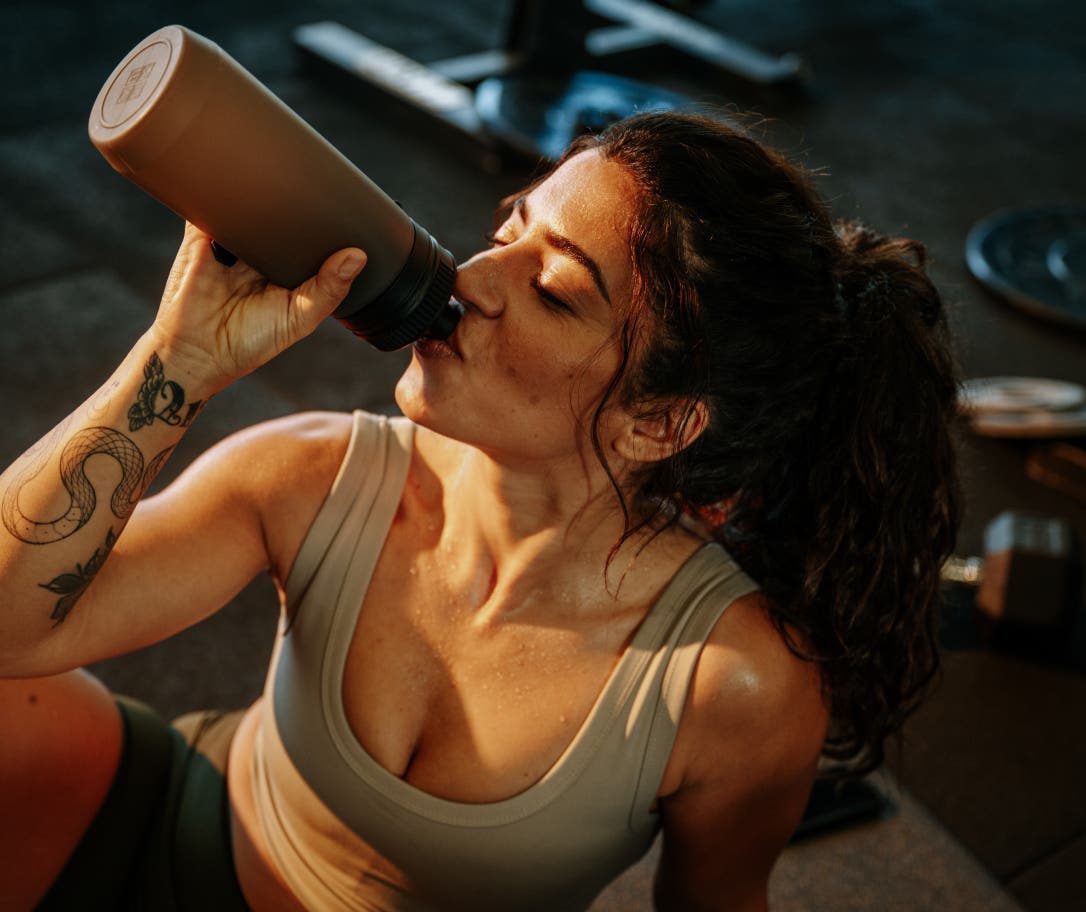Just like cars, our bodies need the right fuel to perform at their best. What you eat before and after exercise impacts your energy levels, endurance, muscle growth, and your overall athletic performance.
Whether you’re lifting heavy, sprinting, or recovering after a long-distance run, nutrition is an important factor in maximizing your efforts and helping you reach your fitness goals.
In this article, we deep dive into the importance of sports nutrition for Free Athletes and why it should be a core part of your overall training regime.
Food as fuel
Below is the Freeletics food pyramid, which makes it easier to visualize the nutritional components that make up an ideal athlete’s diet.

The base of the pyramid and bulk of your diet should come from minimally processed, high-quality, whole foods that are nutrient-dense - Tier 1.
Tier 1 - A well-balanced diet
This is a combination of macronutrients – carbohydrates, proteins, and fats – and micronutrients. The body relies heavily on your macronutrient intake to fuel your physical activity, and the way you eat can profoundly impact your:
- Energy levels: eating the right macronutrients in the correct quantities can sustain your energy and prevent fatigue.
- Muscle repair and growth: protein intake is essential for muscle repair after workouts.
- Recovery: proper post-workout nutrition can support the recovery process, preventing muscle soreness, and preparing you for your next session.
However, the ideal ratio of fat, protein, and carbohydrates will depend on the type of workout you do. For example, aerobic exercise or endurance workouts will require carbohydrates and, to a lesser extent, fat for fuel.
For strength and weight training, a higher protein intake is essential for recovery and growth, while carbohydrates remain important for fueling intense workouts.
Tier 2 - Sport-specific nutrition
These are the foods and drinks you should reach for when tier 1 options aren’t available, like during a workout. Think sports bars, gels, and protein shakes.
Tier 3 - Supplements
These are the dietary supplements you can consider if your diet lacks them or you have specific targets to meet. They can include:

How the body breaks down food for energy
Energy comes from the food we eat via digestion and metabolism. When you eat, the solids and liquids are broken down into their macronutrient components.
These are then further processed into simpler compounds that can be used by the body or stored as energy, including:
- glucose (carbohydrates)
- amino acids (proteins)
- fatty acids (fats)
The specific fuel used by your body will depend on several factors, including the intensity and duration of your workout. For example:
Carbs
Carbohydrates are your body’s go-to energy source, especially during high-intensity activities. They’re broken down into glucose, which fuels your muscles quickly. For example, high-intensity interval training (HIIT) relies heavily on glycogen, the stored form of glucose in your muscle tissues.
When needed, glycogen is rapidly converted into ATP (your body’s energy currency) through a process called glycogenolysis, allowing for quick muscle contractions.1
Cardio-based workouts like running and cycling also need carbohydrates, specifically in the form of circulating glucose, which is readily available to your muscles and can be quickly broken down to provide energy during exercise, similar to HIIT.
Protein
Protein isn’t a major fuel during workouts, but it plays a critical role in recovery and muscle growth. Post-exercise protein intake is broken down into amino acids, which help repair damaged muscle fibers and support the development of stronger, leaner muscle tissue.2
Fat
Fats are a key fuel source during low to moderate-intensity exercise, like walking, hiking, or long-distance steady-state cardio. In these examples, fat stored in your body (adipose tissue) is broken down into fatty acids, which are released into the bloodstream and used by muscles for energy.
Fat also supports recovery and aids in overall tissue repair.3

Should you train on an empty stomach?
The short answer is – it depends. The reality is that intense training without properly fueling can significantly impact your sports performance. Without adequate fuel, you won’t have readily available energy, which can cause fatigue, dizziness, and reduced intensity.
While intermittent fasting does boast some impressive health benefits, it’s also crucial to understand the importance of eating before a workout.
Regularly training on an empty stomach can have wider detrimental effects on your overall health and impair the normal function of your organs and bodily systems, known as relative energy deficiency in sports or RED-S.4
What to eat before different workouts
The timing of your meals is key because it ensures your body has the nutrients it needs to meet the energy demands being placed upon it, and also helps you get the most out of your workout.
Usually, pre-workout nutrition should take place within an hour of exercise,5 but some studies have studied the effect of eating a carbohydrate-rich meal up to 4 hours before exercise and found that it benefits performance.6
However, when you should eat and the best types of food will depend on the type of training sessions you’re doing. For a complete breakdown, make sure to check out our article on what to eat before, during, and after a workout based on your goals.

Hydration and supplementation
Hydration is an important factor for any type of workout. You’ll need to have an adequate fluid intake before, during, and after your session to reduce the risk of dehydration.
There is no standard for the amount of water you should drink because it can be influenced by several factors, including the intensity, duration, and type of activity you are completing.
Here’s our recommendation as a starting point:
- Before exercise: Drink water with meals to ensure pre-exercise hydration and consider drinking 450-600 ml 4 hours before training
- During exercise: Drink according to how thirsty you feel and avoid drinking more than 800 ml per hour. You should consider increasing fluid intake according to the environmental temperature.
- After exercise: Drink 450-680 ml of water for every pound or 0.5 kg lost during exercise7 to replace lost fluids.
Water is usually the best way to replace lost fluids during exercise, but if your session lasts for more than 60 minutes, you may want to consider a sports drink to replace lost electrolytes.
Electrolytes are essential minerals like sodium, potassium, magnesium, calcium, and chloride. Together, they help to maintain fluid balance and ensure your muscles work properly.
If your electrolytes are out of balance, it can disrupt your normal body function. Strenuous exercise can cause an electrolyte imbalance, but sports drinks that include sodium and potassium can help restore lost electrolytes.
Key supplements for performance and recovery
Supplement | Benefits | Best for | How to use |
Caffeine | Improves endurance, increases focus, and reduces perceived effort | Strength training, HIIT, endurance workouts | 3 to 9 mg/kg 60 minutes before exercise |
Protein powder | Aids in building muscle and recovery | Strength training and high-intensity exercise | 1.4 to 2 g/kg of body weight |
Creatine | Natural energy source for muscles, muscle growth and repair, cognition | Strength training, HIIT | 3 g/day |
Let’s recap
Achieving performance gains goes beyond just training – how you fuel your body plays a key role in seeing results. And it’s not a one-size-fits-all approach.
The best workout nutrition depends on the type of exercise, your training goals, and how your body responds to food. Test it out!
Experiment with different pre-and post-workout meals to find what is best for you. Using the Freeletics Food Pyramid as a guide while prioritizing whole, nutrient-dense foods will help you optimize performance and recovery.
Sources
[1] Murray, B., & Rosenbloom, C. (2018). Fundamentals of glycogen metabolism for coaches and athletes. Nutrition reviews, 76(4), 243–259. Available here
[2] Morton, R. W., Murphy, K. T., McKellar, S. R., Schoenfeld, B. J., Henselmans, M., Helms, E., Aragon, A. A., Devries, M. C., Banfield, L., Krieger, J. W., & Phillips, S. M. (2018). A systematic review, meta-analysis and meta-regression of the effect of protein supplementation on resistance training-induced gains in muscle mass and strength in healthy adults. British journal of sports medicine, 52(6), 376–384. Available here
[3] Lundsgaard, A. M., Fritzen, A. M., & Kiens, B. (2020). The Importance of Fatty Acids as Nutrients during Post-Exercise Recovery. Nutrients, 12(2), 280. Available here
[4] Dave, S. C., & Fisher, M. (2022). Relative energy deficiency in sport (RED - S). Current problems in pediatric and adolescent health care, 52(8), 101242. Available here
[5] Arent, S. M., Cintineo, H. P., McFadden, B. A., Chandler, A. J., & Arent, M. A. (2020). Nutrient Timing: A Garage Door of Opportunity?. Nutrients, 12(7), 1948. Available here
[6] Ormsbee, M. J., Bach, C. W., & Baur, D. A. (2014). Pre-exercise nutrition: the role of macronutrients, modified starches and supplements on metabolism and endurance performance. Nutrients, 6(5), 1782–1808. Available here
[7] Roy BA. Exercise and fluid replacement: Brought to you by the... : ACSM’s Health & Fitness Journal [Internet]. [cited 2025 Mar 12]. Available here